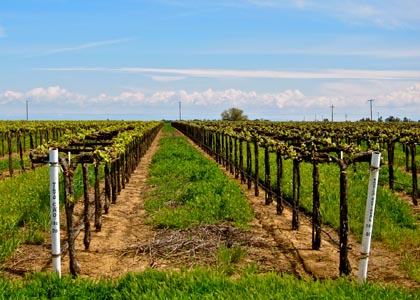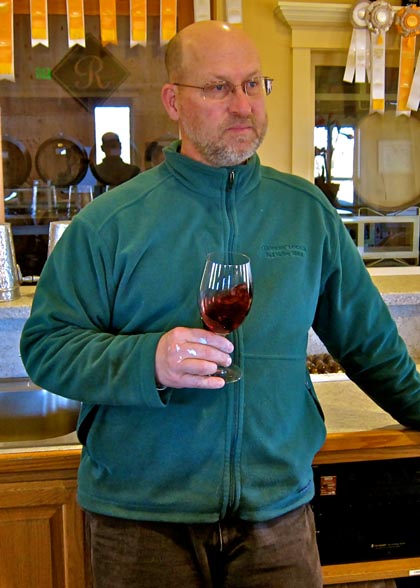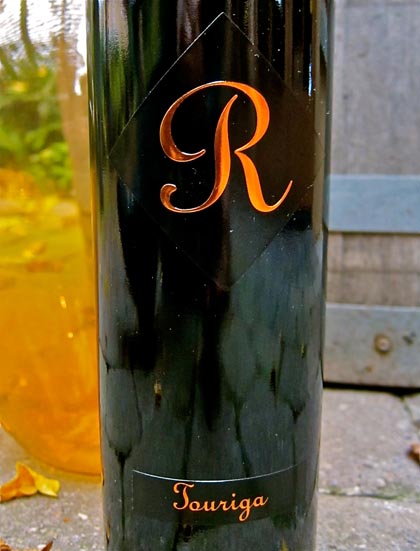Letters from Lodi
An insightful and objective look at viticulture and winemaking from the Lodi
Appellation and the growers and vintners behind these crafts. Told from the
perspective of multi-award winning wine journalist, Randy Caparoso.
Last of the great unknowns
Tinta Cao & Touriga Nacional at Silvaspoons Vineyards
Little known Portuguese grapes that blow your mind…
You can always tell the best winemakers: they are always the most curious, or just plain restless. It was his search for red wine alternatives to the big Zinfandels for which he had become known, eight years ago, that led Jeff Runquist — the winemaker/proprietor of Jeff Runquist Wines, based in Amador County — to Ron Silva, Lodi’s Portuguese grape king, and grower/proprietor of Silvaspoons Vineyards and Alta Mesa Wines.
At first Runquist worked with Silvaspoons Vineyards Grenache, but soon after Silva convinced Runquist to also try his Lodi grown Touriga Nacional: long considered the pre-eminent grape in its native Portugal; particularly in the Douro Valley — the original home of the famous, sweet fortified wines known as Port — and in other regions such as Dão and Tejo, where it forms the backbone of many sturdy, dry table reds blended with other grapes.
Jeff Runquist
While skeptical, Runquist had grown to trust in Mr. Silva, described by Runquist as “more passionate about his grapes than I am about my wines, which is saying a lot.” Of his inaugural vintage of Touriga Nacional, a 2006, Runquist says, “we liked it from the first… we got a really nice black and red raspberry fruit orientation that really hits a sweet spot, a natural expression of forward fruit that reminded me almost of Zinfandel, but different.”
Our own tasting of Runquist’s latest release, the 2009 R Silvaspoons Touriga ($24), confirms the initial assessment: a rock solid yet achingly rich, smooth red wine sporting lush, sweet toned berry aromas tinged with vanilla, with suave yet elemental flavors pushing out from a zesty, medium-full center — a near perfect matrix of intriguing intensity and pure, joyous drinkability. (Note: although Silva also grows Touriga Nacional’s more feminine sister grape, Touriga Franca, Runquist utilizes Touriga Nacional exclusively in his “Touriga”).
Experiencing a wine as effortlessly good as this, you cannot help but wonder: why, then, is Touriga Nacional such an obscurity; and as a varietal table red, still rare in its native Portugal, and practically unheard of in California?
That’s the sixty million dollar question that’s also been publicly aired in recent years by Portugal’s trade arm, VINIPortugal, in their search for solutions to the steadily declining sales of authentic Port around the world. While Touriga Nacional may be considered Portugal’s finest grape — thus having the highest percentage chance of turning the world on to dry, rather than the unfashionably sweet, wines of Portugal — it is rarely bottled as an unblended varietal because of the very qualities for which it is prized: a tremendous intensity of both violet-like fruitiness and hard, drying tannin derived from the vine’s propensity to grow clusters of markedly small, thick skinned, deeply pigmented berries. A high skin to juice ratio not unlike that of, say, Cabernet Sauvignon, to which Touriga is unrelated (Portugal’s native grapes began adapting to the country’s warm, arid growing conditions some 2,000 years ago, pretty much isolated from other varieties belonging to the European family of grapes, known as Vitis vinifera).
In France’s Bordeaux region, Cabernet Sauvignon is traditionally blended with grapes like Merlot, Cabernet Franc, Malbec, and Petit Verdot to tone down its excesses of body and tannin. For similar reasons, in Portugal Touriga Nacional is commonly blended with grapes like Touriga Franca, Tinta Roriz (the Portuguese variant of Tempranillo), Tinta Cão — heck, sometimes even Cabernet Sauvignon — in order to tame the beastly tendencies.
Yet you would think: here’s a thick skinned grape, like Cabernet Sauvignon, that produces wines of noble character and grand proportion, and thrives in a warm, seasonal Mediterranean climate — a no-brainer for California, right? Alas, at last count (2010), California Agricultural Statistics Service reports over 77,000 acres of Cabernet Sauvignon planted in the Golden State. Touriga Nacional? 227 acres.
It is Touriga’s association with Port style wines, of course, which accounts for the historical indifference to the grape in the U.S. Virtually all the major plantings in California have been done with the traditional mix of other Portuguese grapes, primarily for the purpose of producing sweet fortified wine. In Portugal as it is in California, hope springs eternal that Touriga Nacional might soon become known as a great grape for varietal bottlings, even if a day late and a dollar short.
Bringing up still another high quality Portuguese grape, according to Runquist, that has long gone unappreciated: one that is called Souzão. Like Touriga, Souzão is used in the Douro to produce Port; although there, it serves a very minor role. But listening to Runquist talk, you would think the opposite. “The Portuguese might not appreciate Souzão,” he says, “but it is a variety that can make Touriga taste light… it has a thickness and viscosity without a lot of tannin, very moderate alcohol, plus a zippiness that is just phenomenal. Yes, it’s different, even a little off the wall, but it has virtually no negative. We’ve been batting a thousand with it — our Souzão takes home a gold medal in every competition in which it is entered.”
The amazing thing: Runquist does not exaggerate: the 2009 R Silvaspoons Souzão ($24), also sourced from Silva’s Lodi vineyard, oozes with ripe toned, strawberry/black cherry fruitiness, sweetened by a little oak, yet tasting fruit forward from beginning to end within its firm, medium body (13.5% alcohol), unimpeded by tannin, and ultimately: juicy, mouth-watering, fresh, lively, lovely.
In respect to food matches, Runquist is even more bullish. “I like Touriga with zesty Mediterranean cooking,” he tells us, “even saltier dishes, with anchovy, capers and sausage, are enhanced by the brightness and acidity of Touriga.” The most unlikely match? Runquist has gone so far as enjoying “Touriga with mixed berries over yoghurt” — although that might be a personal choice. How about this, instead: ribbons of pasta or salads dressed up with generous chunks of smoked bacon; the former whipped with cream and eggs (alla carbonara), the latter with slices of boiled egg.
Despite its lower tannin, Runquist thinks of Souzão as an even fuller flavored wine; and for that, “braised meats, like rabbit and lamb, come to mind.” Check out, for example, these recipes for hunter’s hare stew and braised lamb shanks with caramelized onions and shallots; and once you get the idea of the gelatinous viscosity and brothy, earthy flavors to shoot for, you can cook up your own variations.
As rare as it might be today, you can never keep a good grape down; so you owe it to yourself to check out these great unknowns at either the Jeff Runquist Winery & Tasting Room in Plymouth, or your friendly neighborhood Lodi Wine & Visitor Center.




